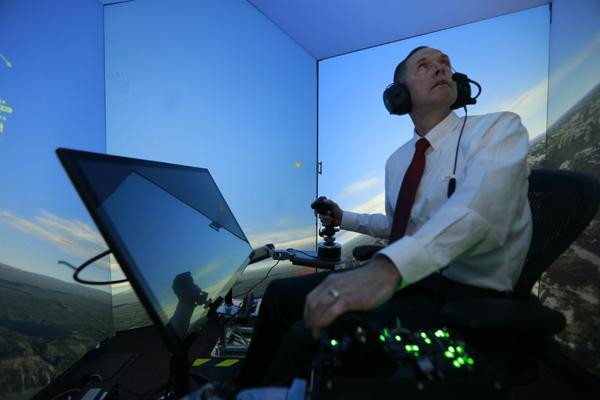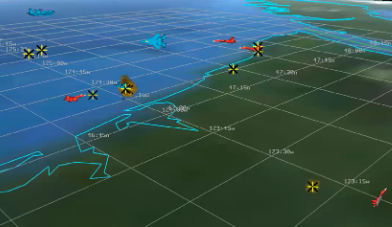AI beats top U.S. Air Force tactical air combat experts in combat simulation
June 28, 2016

Retired U.S. Air Force Colonel Gene Lee, in a flight simulator, takes part in simulated air combat versus artificial intelligence technology developed by a team from industry, the U.S. Air Force, and University of Cincinnati. (credit: Lisa Ventre, University of Cincinnati Distribution A: Approved for public release; distribution unlimited. 88ABW Cleared 05/02/2016; 88ABW-2016-2270)
The U.S. Air Force got a wakeup call recently when AI software called ALPHA — running on a tiny $35 Raspberry Pi computer — repeatedly defeated retired U.S. Air Force Colonel Gene Lee, a top aerial combat instructor and Air Battle Manager, and other expert air-combat tacticians at the U.S. Air Force Research Lab (AFRL) in Dayton, Ohio. The contest was conducted in a high-fidelity air combat simulator.
According to Lee, who has considerable fighter-aircraft expertise (and has been flying in simulators against AI opponents since the early 1980s), ALPHA is “the most aggressive, responsive, dynamic and credible AI I’ve seen to date.” In fact, he was shot out of the air every time during protracted engagements in the simulator, he said.
ALPHA’s secret? Custom-designed “genetic fuzzy” algorithms designed for simulated air-combat missions, according to an open-access, unclassified paper published in the authoritative Journal of Defense Management. The paper was authored by a team of industry, Air Force, and University of Cincinnati researchers, including the AFRL Branch Chief.
ALPHA, which now runs on a standard consumer-grade PC, was developed by Psibernetix, Inc., an AFRL contractor founded by University of Cincinnati College of Engineering and Applied Science 2015 doctoral graduate Nick Ernest*, president and CEO of the firm, and a team of former Air Force aerial combat experts, including Lee.
“AI wingmen”
Today’s fighters close in on each other at speeds in excess of 1,500 miles per hour while flying at altitudes above 40,000 feet. The cost for a mistake is very high. Microseconds matter, but an average human visual reaction time is 0.15 to 0.30 seconds, and “an even longer time to think of optimal plans and coordinate them with friendly forces,” the researchers note in the paper.

Side view during active combat in simulator between two Blue (human-controlled) fighters vs. four Red (AI) fighters with >150 inputs but handicapped data sources. All Reds have successfully evaded missiles; one Blue has been destroyed. Blue AWACS [Airborne early warning and control system aircraft] shown in distance. (credit: Nicholas Ernest et al./Journal of Defense Management)
According to the AFRL team, ALPHA will first be tested on “Unmanned Combat Aerial Vehicles (UCAV),” where ALPHA will be organizing data and creating a complete mapping of a combat scenario, such as a flight of four fighter aircraft — which it can do in less than a millisecond.
The AFRL team sees ACAVs as “AI wingmen” capable of engaging in air combat when teamed with manned aircraft.
The ACAVs will include an onboard battle management system able to process situational awareness, determine reactions, select tactics, and manage weapons — simultaneously evading dozens of hostile missiles, taking accurate shots at multiple targets, coordinating actions of squad mates, and recording and learning from observations of enemy tactics and capabilities.
Genetic fuzzy systems
The researchers based the design of ALPHA on a “genetic fuzzy tree” (GFT) — a subtype of “fuzzy logic” algorithms. The GFT is described in another open-access paper in Journal of Defense Management by Ernest and University of Cincinnati aerospace professor Kelly Cohen.
“Genetic fuzzy systems have been shown to have high performance, and a problem with four or five inputs can be solved handily,” said Cohen. “However, boost that to a hundred inputs, and no computing system on planet Earth could currently solve the processing challenge involved — unless that challenge and all those inputs are broken down into a cascade of sub-decisions.
“Most AI programming uses numeric-based control and provides very precise parameters for operations,” he said. In contrast, the AI algorithms that Ernest and his team developed are language-based, with if/then scenarios and rules able to encompass hundreds to thousands of variables. This language-based control, or fuzzy logic, can be verified and validated, Cohen says.
The “genetic” part of the “genetic fuzzy tree” system started with numerous automatically generated versions of ALPHA that proved themselves against a manually tuned version of ALPHA. The successful strings of code were then “bred” with each other, favoring the stronger, or highest performance versions.
In other words, only the best-performing code was used in subsequent generations. Eventually, one version of ALPHA rises to the top in terms of performance, and that’s the one that is utilized.
“In terms of emulating human reasoning, I feel this is to unmanned aerial vehicles as the IBM Deep Blue vs. Kasparov was to chess,” said Cohen. Or as Alpha Go was to Go.
* Support for Ernest’s doctoral research was provided by the Dayton Area Graduate Studies Institute and the U.S. Air Force Research Laboratory.
UC | Flying in Simulator
Abstract of Genetic Fuzzy based Artificial Intelligence for Unmanned Combat Aerial Vehicle Control in Simulated Air Combat Missions
Breakthroughs in genetic fuzzy systems, most notably the development of the Genetic Fuzzy Tree methodology, have allowed fuzzy logic based Artificial Intelligences to be developed that can be applied to incredibly complex problems. The ability to have extreme performance and computational efficiency as well as to be robust to uncertainties and randomness, adaptable to changing scenarios, verified and validated to follow safety specifications and operating doctrines via formal methods, and easily designed and implemented are just some of the strengths that this type of control brings. Within this white paper, the authors introduce ALPHA, an Artificial Intelligence that controls flights of Unmanned Combat Aerial Vehicles in aerial combat missions within an extreme-fidelity simulation environment. To this day, this represents the most complex application of a fuzzy-logic based Artificial Intelligence to an Unmanned Combat Aerial Vehicle control problem. While development is on-going, the version of ALPHA presented within was assessed by Colonel (retired) Gene Lee who described ALPHA as “the most aggressive, responsive, dynamic and credible AI (he’s) seen-to-date.” The quality of these preliminary results in a problem that is not only complex and rife with uncertainties but also contains an intelligent and unrestricted hostile force has significant implications for this type of Artificial Intelligence. This work adds immensely to the body of evidence that this methodology is an ideal solution to a very wide array of problems.
